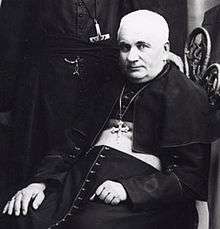Vital-Justin Grandin
Vital-Justin Grandin (8 February 1829 – 3 June 1902) was a Roman Catholic priest and bishop. He served the Church in the western parts of what is now Canada both before and after Confederation and was an early supporter of the Canadian Indian residential school system.
Vital-Justin Grandin | |
|---|---|
| Bishop of St. Albert | |
 Vital-Justin Grandin, c. 1900 | |
| Diocese | Diocese of St. Albert |
| In office | 1871–1902 |
| Successor | Émile-Joseph Legal |
| Other posts | Bishop of Satala (titular) |
| Orders | |
| Ordination | 1854 (priest) |
| Consecration | 1859 |
| Personal details | |
| Born | 8 February 1829 Saint-Pierre-sur-Orthe, France |
| Died | 3 June 1902 (aged 73) St. Albert, Alberta, Canada |
| Denomination | Roman Catholic |
Early life
Grandin was born in Saint-Pierre-sur-Orthe, France, on 8 February 1829. He was the ninth son in a family of fourteen children of Jean Grandin and Marie Veillard. He was ordained as a priest in 1854; one month later he was sent by the Missionary Oblates of Mary Immaculate to Canada to perform missionary work in what was then Rupert's Land. Upon arrival he was sent to Saint-Boniface, where Bishop Alexandre-Antonin Taché was in charge. Grandin was subsequently assigned to a mission at Fort Chipewyan (now in Alberta). He next served at Île-à-la-Crosse (now in Saskatchewan) for a number of years.[1]
Life as bishop
In 1867, Taché proposed that the vicariate of Saskatchewan be formed with Grandin as vicar of missions. This took place in 1868; in the same year, Grandin attended the council of Quebec bishops in 1868 to discuss new religious boundaries in the Canadian northwest. As a result of these discussions, St. Boniface was elevated and the suffragan diocese of St Albert was created. In 1871, Vital-Justin Grandin was appointed bishop.
Grandin was an early supporter of the Canadian Indian residential school system believing that the best way to civilize Indigenous peoples was to educate the young. In 1880 he wrote a letter to then Public Works Minister Hector-Louis Langevin explaining that boarding schools were the best way to ensure children "forget the customs, habits & language of their ancestors".[2]:159
Grandin was never completely healthy; he had been a sickly child and also had a speech impediment, and his health deteriorated during his later years. He did however preside over the development and expansion of the Diocese of St. Albert, including the founding of new missions and churches throughout Alberta and the construction of hospitals and schools which, unusually for the time, were administered by members of female religious orders and lay clergy. Grandin's efforts to increase Francophone settlement in Alberta were less successful, but many francophone communities founded at the behest of Grandin (such as Beaumont, Lacombe, and Morinville) still exist in central and Northern Alberta.
Bishop Grandin died in office on 3 June 1902. He was declared venerable by the Roman Catholic Church in 1966.
Upon his death, Grandin was succeeded by Bishop Émile-Joseph Legal in the St. Albert diocese.
Legacy
- Grandin, a neighbourhood in St. Albert, Alberta
- Vital Grandin Catholic Elementary School in St. Albert, Alberta
- Grandin LRT station plus adjacent Grandin neighbourhood in Edmonton, Alberta
- Bishop Grandin Boulevard, also known as Winnipeg Route 165
- Bishop Grandin Greenway, a major redevelopment area in Winnipeg[3]
- St. Vital, a neighbourhood and a provincial electoral riding in Winnipeg, Manitoba, named after Bishop Grandin's patron saint, Saint Vitalis of Milan [4]
- St. Vital Centre, a shopping mall in Winnipeg, Manitoba, named after Bishop Grandin's patron saint, Saint Vitalis of Milan
- Bishop Grandin High School, a secondary school in Calgary, Alberta under the Calgary Catholic School District
- Numerous Catholic elementary schools in Alberta and Manitoba
- In Australia the Grandin sporting house at Mazenod College in Victoria is named after Bishop Grandin. [5] (Mazenod College, Victoria)
- In Australia the Grandin sporting house at Iona College in Brisbane is named after Bishop Grandin
- In Australia the Grandin sporting house at Mazenod College in Western Australia is named after Bishop Grandin.
Notes
- Jonquet, Émile (1903). Mgr. Grandin oblat de MArie Immaculée premier évêque de Saint-Albert (in French) (first ed.). Montréal: s. n. p. 1. OL 24604153M.
- "Canada's Residential Schools: The History, Part 1 Origins to 1939: Final Report of the Truth and Reconciliation Commission of Canada Volume 1" (PDF). National Centre for Truth and Reconciliation. Truth and Reconciliation Commission of Canada. 2015. Retrieved July 1, 2016.
- Home - Bishop Grandin Greenway at www.bishopgrandingreenway.com
- William J. Fraser, "Bishop Grandin Remembered", Manitoba History Society, accessed 14 September 2009.
- "Houses - Mazenod College". Mazenod College. Retrieved 2018-10-30.